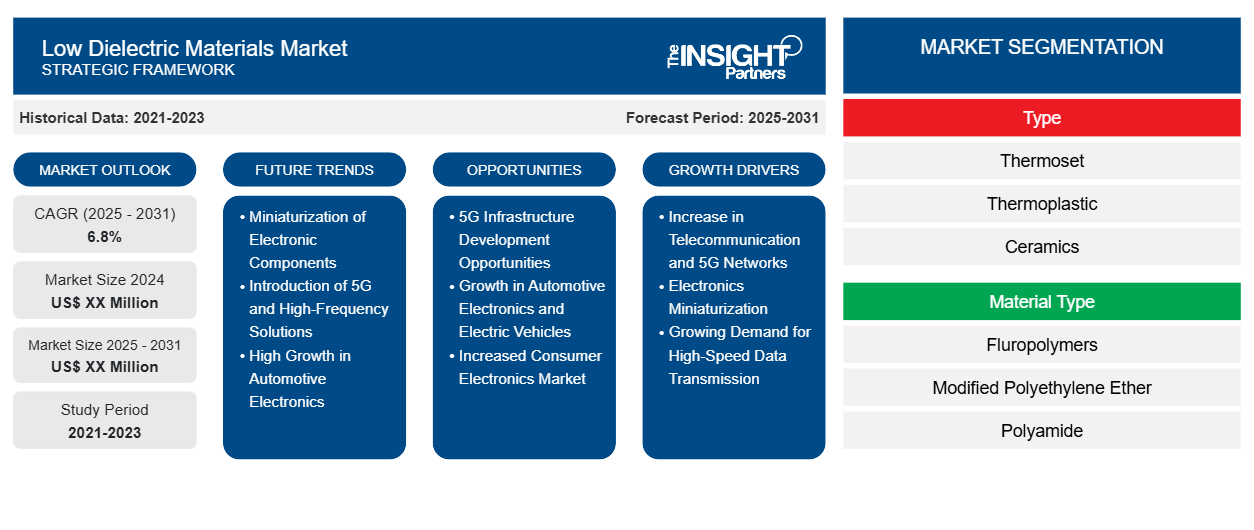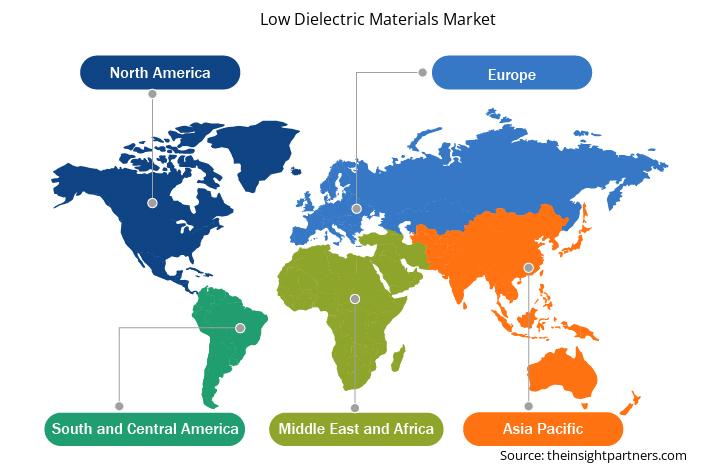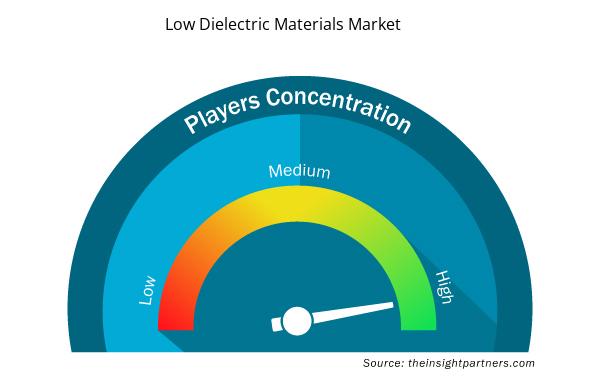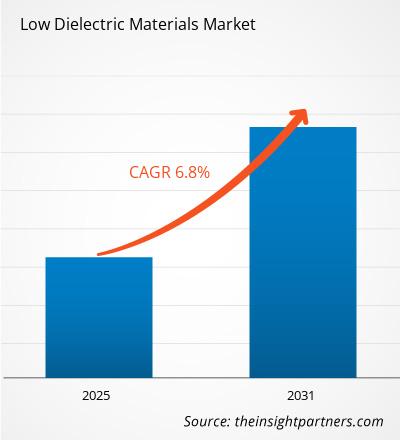The Low Dielectric Materials Market is expected to register a CAGR of 6.8% from 2025 to 2031, with a market size expanding from US$ XX Million in 2024 to US$ XX Million by 2031.
The low dielectric materials market report is segmented by Type (Thermoset, Thermoplastic, Ceramics, and Others). The market is segmented based on Material Type (Fluropolymers, Modified Polyethylene Ether, Polyamide, Liquid Crystal Polymer, and Others) and Application (Printed Circuit Boards, Antenna, Microelectronics, Wire and Cable, and Others). The market size and forecast at global, regional, and country levels for all the key market segments are covered under the scope. The report offers the value in USD for the above analysis, segments, regions, and countries. The report covers market trends, as well as market dynamics such as drivers, restraints, and key opportunities. The report also covers industry landscape and competition analysis covering market concentration, heat map analysis, prominent players, and recent developments in the market.
Purpose of the Report
The report Low Dielectric Materials Market by The Insight Partners aims to describe the present landscape and future growth, top driving factors, challenges, and opportunities. This will provide insights to various business stakeholders, such as:
- Technology Providers/Manufacturers: To understand the evolving market dynamics and know the potential growth opportunities, enabling them to make informed strategic decisions.
- Investors: To conduct a comprehensive trend analysis regarding the market growth rate, market financial projections, and opportunities that exist across the value chain.
- Regulatory bodies: To regulate policies and police activities in the market with the aim of minimizing abuse, preserving investor trust and confidence, and upholding the integrity and stability of the market.
Low Dielectric Materials Market Segmentation
Type
- Thermoset
- Thermoplastic
- Ceramics
Material Type
- Fluropolymers
- Modified Polyethylene Ether
- Polyamide
- Liquid Crystal Polymer
Application
- Printed Circuit Boards
- Antenna
- Microelectronics
- Wire and Cable
Customize This Report To Suit Your Requirement
You will get customization on any report - free of charge - including parts of this report, or country-level analysis, Excel Data pack, as well as avail great offers and discounts for start-ups & universities
Low Dielectric Materials Market: Strategic Insights

- Get Top Key Market Trends of this report.This FREE sample will include data analysis, ranging from market trends to estimates and forecasts.
Low Dielectric Materials Market Growth Drivers
- Increase in Telecommunication and 5G Networks: The surge in telecommunication with an increase in 5G networks is in direct need of low dielectric materials. These are a part of a requirement to better transmit the signal and ensure minimum loss of signal. In a high-frequency setup, such materials are considered essential as the demand for more effective communication systems has been rising. Low dielectric materials support the overall performance of antennas, cables, etc.
- Electronics Miniaturization: The advancement of the low dielectric materials market is highly dependent on miniaturization of electronics. The smaller size of the electronics demands low signal loss material for efficient performance in a small size. Thus, for such applications where smartphones and wearables require the essential electrical insulation for high-speed data transmission, the application of low dielectric material is critical.
- Growing Demand for High-Speed Data Transmission: The increasing need for high-speed data transmission in sectors like data centers, automotive, and computing is driving up the demand for low dielectric materials. These increase signal integrity and minimize interference, promoting faster and more efficient transfer of data. With companies looking to meet the heightened demand for high-speed communications, low dielectric material is increasingly becoming a feature in the development of highly advanced electronic systems.
Low Dielectric Materials Market Future Trends
- Miniaturization of Electronic Components: A significant trend in the low dielectric materials market is the continuous miniaturization of electronic components. The smaller the devices, the greater the need for materials that have low signal loss and high-frequency performance in compact spaces. Low dielectric materials, such as advanced polymers and ceramics, are critical to meeting the size, weight, and efficiency requirements of miniature electronics in consumer devices and automotive systems.
- Introduction of 5G and High-Frequency Solutions: The global trend toward the application of 5G technology and other high-frequency communication systems is significantly affecting the low dielectric materials market. These materials play an important role in signal reduction and ensuring efficient transmission through 5G networks, radar systems, and high-speed data cables. Growing demand for low dielectric materials in these applications with advanced telecommunication and wireless connectivity continues.
- High Growth in Automotive Electronics: The demand for low dielectric materials will continue to increase due to the high integration of advanced electronics in automotive systems. Such materials are required for the guarantee of signal integrity and performance in automotive applications, including electric vehicles (EVs), autonomous driving sensors, and in-car infotainment systems. The increase in connectivity and technology within vehicles will play a huge role in requiring low dielectric materials in order to create effective communication systems.
Low Dielectric Materials Market Opportunities
- 5G Infrastructure Development Opportunities: The rollout of 5G networks globally will create a huge opportunity for the low dielectric materials market. Since 5G technology requires high-frequency, low-loss materials to provide fast and reliable data transmission, the demand for low dielectric materials is likely to increase significantly. Low dielectric materials are required in the fabrication of antennas, cables, and communication devices, making the telecommunications infrastructure manufacturing industry very lucrative.
- Growth in Automotive Electronics and Electric Vehicles: With the emergence of electric vehicles (EVs) and an increasing trend towards automotive automation, low dielectric materials hold significant market opportunities. These materials play a significant role in enhancing the performance of in-car electronics such as radar sensors, infotainment systems, and power electronics. With rising adoption of EVs and the complexity of automotive electronics, demand for low dielectric materials is bound to grow, unlocking new market opportunities in the automotive industry.
- Increased Consumer Electronics Market: The growing consumer electronics market, including smartphones, wearables, and IoT devices, is a key opportunity for low dielectric materials. As these devices become more compact and high-performing, the need for materials that ensure low signal loss and high-speed data transfer grows. Manufacturers in the electronics industry will increasingly rely on low dielectric materials for efficient and reliable operation, opening new avenues for growth.
Low Dielectric Materials Market Regional Insights
The regional trends and factors influencing the Low Dielectric Materials Market throughout the forecast period have been thoroughly explained by the analysts at Insight Partners. This section also discusses Low Dielectric Materials Market segments and geography across North America, Europe, Asia Pacific, Middle East and Africa, and South and Central America.

- Get the Regional Specific Data for Low Dielectric Materials Market
Low Dielectric Materials Market Report Scope
| Report Attribute | Details |
|---|---|
| Market size in 2024 | US$ XX Million |
| Market Size by 2031 | US$ XX Million |
| Global CAGR (2025 - 2031) | 6.8% |
| Historical Data | 2021-2023 |
| Forecast period | 2025-2031 |
| Segments Covered |
By Type
|
| Regions and Countries Covered | North America
|
| Market leaders and key company profiles |
Low Dielectric Materials Market Players Density: Understanding Its Impact on Business Dynamics
The Low Dielectric Materials Market market is growing rapidly, driven by increasing end-user demand due to factors such as evolving consumer preferences, technological advancements, and greater awareness of the product's benefits. As demand rises, businesses are expanding their offerings, innovating to meet consumer needs, and capitalizing on emerging trends, which further fuels market growth.
Market players density refers to the distribution of firms or companies operating within a particular market or industry. It indicates how many competitors (market players) are present in a given market space relative to its size or total market value.
Major Companies operating in the Low Dielectric Materials Market are:
- Huntsman Corporation
- Arxada
- SABIC
- Asahi Kasei
- Topas Advanced Polymers
- Zeon Corp
Disclaimer: The companies listed above are not ranked in any particular order.

- Get the Low Dielectric Materials Market top key players overview
Key Selling Points
- Comprehensive Coverage: The report comprehensively covers the analysis of products, services, types, and end users of the Low Dielectric Materials Market, providing a holistic landscape.
- Expert Analysis: The report is compiled based on the in-depth understanding of industry experts and analysts.
- Up-to-date Information: The report assures business relevance due to its coverage of recent information and data trends.
- Customization Options: This report can be customized to cater to specific client requirements and suit the business strategies aptly.
The research report on the Low Dielectric Materials Market can, therefore, help spearhead the trail of decoding and understanding the industry scenario and growth prospects. Although there can be a few valid concerns, the overall benefits of this report tend to outweigh the disadvantages.
- Historical Analysis (2 Years), Base Year, Forecast (7 Years) with CAGR
- PEST and SWOT Analysis
- Market Size Value / Volume - Global, Regional, Country
- Industry and Competitive Landscape
- Excel Dataset



Report Coverage
Revenue forecast, Company Analysis, Industry landscape, Growth factors, and Trends

Segment Covered
This text is related
to segments covered.

Regional Scope
North America, Europe, Asia Pacific, Middle East & Africa, South & Central America

Country Scope
This text is related
to country scope.
Frequently Asked Questions
The low dielectric materials market is estimated to witness a CAGR of 6.8% from 2025 to 2031
Growth in telecommunications and 5G networks is driving the market growth.
Huntsman Corporation, Arxada, SABIC, Asahi Kasei, Topas Advanced Polymers, Zeon Corp, Chemours Company LLC, DIC Corporation, Arkema, and Mitsubishi Corporation are the key players operating in the low dielectric materials market.
Based on material type, modified polyethylene ether segment is expected to witness the fastest growth during the forecast period.
Based on geography, Asia Pacific held the largest share of the low dielectric materials market.
Increasing use in automotive electronics is expected to be the key market trends.
Trends and growth analysis reports related to Chemicals and Materials : READ MORE..
- Huntsman Corporation
- Arxada
- SABIC
- Asahi Kasei
- Topas Advanced Polymers
- Zeon Corp
- Chemours Company LLC
- DIC Corporation
- Arkema
- Mitsubishi Corporation

 Get Free Sample For
Get Free Sample For